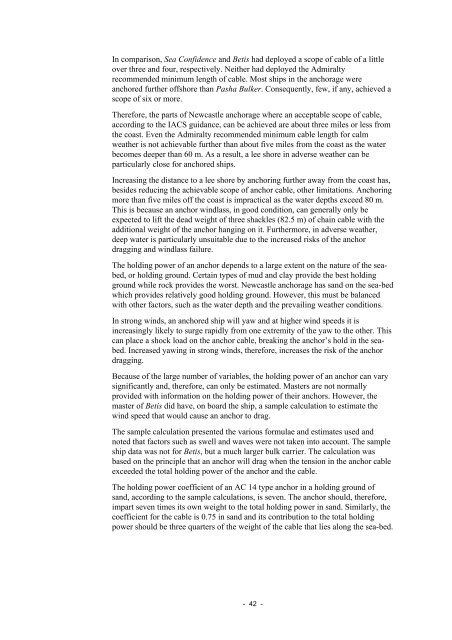Pasha Bulker 243 - Independent investigation into the grounding of ...
Pasha Bulker 243 - Independent investigation into the grounding of ...
Pasha Bulker 243 - Independent investigation into the grounding of ...
You also want an ePaper? Increase the reach of your titles
YUMPU automatically turns print PDFs into web optimized ePapers that Google loves.
In comparison, Sea Confidence and Betis had deployed a scope <strong>of</strong> cable <strong>of</strong> a little<br />
over three and four, respectively. Nei<strong>the</strong>r had deployed <strong>the</strong> Admiralty<br />
recommended minimum length <strong>of</strong> cable. Most ships in <strong>the</strong> anchorage were<br />
anchored fur<strong>the</strong>r <strong>of</strong>fshore than <strong>Pasha</strong> <strong>Bulker</strong>. Consequently, few, if any, achieved a<br />
scope <strong>of</strong> six or more.<br />
Therefore, <strong>the</strong> parts <strong>of</strong> Newcastle anchorage where an acceptable scope <strong>of</strong> cable,<br />
according to <strong>the</strong> IACS guidance, can be achieved are about three miles or less from<br />
<strong>the</strong> coast. Even <strong>the</strong> Admiralty recommended minimum cable length for calm<br />
wea<strong>the</strong>r is not achievable fur<strong>the</strong>r than about five miles from <strong>the</strong> coast as <strong>the</strong> water<br />
becomes deeper than 60 m. As a result, a lee shore in adverse wea<strong>the</strong>r can be<br />
particularly close for anchored ships.<br />
Increasing <strong>the</strong> distance to a lee shore by anchoring fur<strong>the</strong>r away from <strong>the</strong> coast has,<br />
besides reducing <strong>the</strong> achievable scope <strong>of</strong> anchor cable, o<strong>the</strong>r limitations. Anchoring<br />
more than five miles <strong>of</strong>f <strong>the</strong> coast is impractical as <strong>the</strong> water depths exceed 80 m.<br />
This is because an anchor windlass, in good condition, can generally only be<br />
expected to lift <strong>the</strong> dead weight <strong>of</strong> three shackles (82.5 m) <strong>of</strong> chain cable with <strong>the</strong><br />
additional weight <strong>of</strong> <strong>the</strong> anchor hanging on it. Fur<strong>the</strong>rmore, in adverse wea<strong>the</strong>r,<br />
deep water is particularly unsuitable due to <strong>the</strong> increased risks <strong>of</strong> <strong>the</strong> anchor<br />
dragging and windlass failure.<br />
The holding power <strong>of</strong> an anchor depends to a large extent on <strong>the</strong> nature <strong>of</strong> <strong>the</strong> seabed,<br />
or holding ground. Certain types <strong>of</strong> mud and clay provide <strong>the</strong> best holding<br />
ground while rock provides <strong>the</strong> worst. Newcastle anchorage has sand on <strong>the</strong> sea-bed<br />
which provides relatively good holding ground. However, this must be balanced<br />
with o<strong>the</strong>r factors, such as <strong>the</strong> water depth and <strong>the</strong> prevailing wea<strong>the</strong>r conditions.<br />
In strong winds, an anchored ship will yaw and at higher wind speeds it is<br />
increasingly likely to surge rapidly from one extremity <strong>of</strong> <strong>the</strong> yaw to <strong>the</strong> o<strong>the</strong>r. This<br />
can place a shock load on <strong>the</strong> anchor cable, breaking <strong>the</strong> anchor’s hold in <strong>the</strong> seabed.<br />
Increased yawing in strong winds, <strong>the</strong>refore, increases <strong>the</strong> risk <strong>of</strong> <strong>the</strong> anchor<br />
dragging.<br />
Because <strong>of</strong> <strong>the</strong> large number <strong>of</strong> variables, <strong>the</strong> holding power <strong>of</strong> an anchor can vary<br />
significantly and, <strong>the</strong>refore, can only be estimated. Masters are not normally<br />
provided with information on <strong>the</strong> holding power <strong>of</strong> <strong>the</strong>ir anchors. However, <strong>the</strong><br />
master <strong>of</strong> Betis did have, on board <strong>the</strong> ship, a sample calculation to estimate <strong>the</strong><br />
wind speed that would cause an anchor to drag.<br />
The sample calculation presented <strong>the</strong> various formulae and estimates used and<br />
noted that factors such as swell and waves were not taken <strong>into</strong> account. The sample<br />
ship data was not for Betis, but a much larger bulk carrier. The calculation was<br />
based on <strong>the</strong> principle that an anchor will drag when <strong>the</strong> tension in <strong>the</strong> anchor cable<br />
exceeded <strong>the</strong> total holding power <strong>of</strong> <strong>the</strong> anchor and <strong>the</strong> cable.<br />
The holding power coefficient <strong>of</strong> an AC 14 type anchor in a holding ground <strong>of</strong><br />
sand, according to <strong>the</strong> sample calculations, is seven. The anchor should, <strong>the</strong>refore,<br />
impart seven times its own weight to <strong>the</strong> total holding power in sand. Similarly, <strong>the</strong><br />
coefficient for <strong>the</strong> cable is 0.75 in sand and its contribution to <strong>the</strong> total holding<br />
power should be three quarters <strong>of</strong> <strong>the</strong> weight <strong>of</strong> <strong>the</strong> cable that lies along <strong>the</strong> sea-bed.<br />
- 42 -
















